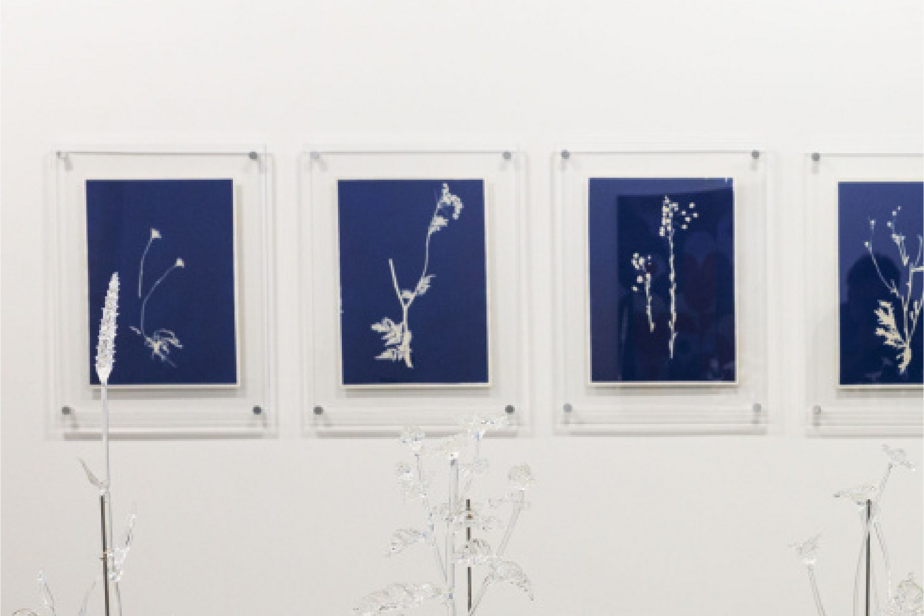Exactly one year after the death of the young Iranian Kurd Mahsa Amini, following her violent arrest by the Tehran morality police – because her hair was sticking out of her veil – the Duran | Montreal’s Mashaal counters with an all-female exhibition featuring six Canadian-Iranian artists.
In the wake of the daily protests that followed in Tehran, the gallery’s co-owner, Sarah Mashaal, whose father is Iranian, felt challenged. “I told myself that the best thing I could do here is to celebrate Iranian visual artists in Canada. So that they can show their works without censorship, without fear of reprisals. »
Sarah Mashaal got in touch with Shadan Saber, an Iranian who has lived in Toronto for around twenty years, who promotes female artists on her platform The Social Collective. Together, the two women who curated the exhibition began looking for artists. Through their contacts or even on social networks.
“We wanted to give them a voice,” insists Shadan Saber, who had no difficulty finding the six artists ofEchoes of Iran.

PHOTO HUGO-SÉBASTIEN AUBERT, THE PRESS
The two curators of the exhibition Echoes of Iran : Sarah Mashaal and Shadan Saber
All the works presented as part of this exhibition had to meet one condition: they all had to have a link with Iranian culture. The result is astonishing. From creating native plants to blown glass (Displaced Gardenby Anahita Norouzi) to a huge black ink drawing evoking the major demonstrations in Tehran (A Forestby Naz Rahbar), the chosen works are all impactful.
“This work by Naz Rahbar, HAS Forest, was carried out over a period of five years, specifies Shadan Saber. It is called Forest because she considers all the people represented as trees united to each other and stronger when they are united. »
We ask the artist Maryam Izadifard, who presents two paintings here, if art is necessarily political for her. The young woman, who arrived in Montreal in 2011, when she was already almost 30 years old, is categorical.
Whatever we do, the artistic gesture is political, in spite of ourselves, especially when we are a woman. Because in Iran we are not free.
Maryam Izadifard
At an exhibition in a gallery in Tehran, Maryam Izadifard painted pictures of women’s bedrooms, including a canvas with an unmade bed, rumpled sheets, earrings lying on the bed and a discarded bra on the ground. No one was depicted in the painting. However, the moral police deemed it immoral and fined the gallery owner. “Just seeing the wrinkled sheets suggested that a woman had slept in them, so it was unacceptable…”

PHOTO HUGO-SÉBASTIEN AUBERT, THE PRESS
Maryam Izadifard in front of the two paintings she exhibits at Duran | Mashaal.
In one of the paintings she exhibits at Duran | Mashaal, The gap kissed, she painted the entrance to a room with two open doors: that of the room itself and that of what we guess is a wardrobe. Hanging on one of the doors is a bra.
This “step back” in a way was caused by the pandemic, she tells us. “The isolation I experienced during the pandemic plunged me into the same feeling of loneliness that I had when I arrived in Montreal,” she explains. It brought me back to these works that I painted, in which I could not show anything, only evoke, and even then…”
Paradoxically, the artist of Iranian origin admits that her works are much more abstract today than when she painted in Iran.
“When I lived there, I felt the unconscious need to represent everything, even if there were lots of things I wasn’t allowed to paint. My art was more figurative. But for this exhibition, I wanted to revisit these somewhat enigmatic works where we don’t really know where we are. There is a domestic aspect, but does life really exist in this place, or is it an abandoned space? »
A video installation
Rojin Shafiei was born in Iran, she arrived here 10 years ago at the age of 20. After studying at Concordia University, she began creating performances and videos. During the protests in Tehran following the death of Mahsa Amini, she organized a performance at Toronto’s White Night.
“In a room lit in red, I broadcast audio extracts of testimonies from women who have had trouble with the moral police,” she summarizes. At one point, women who died in altercations with police or in prison were named. For each death pronounced, I cut a lock of hair. »

PHOTO HUGO-SÉBASTIEN AUBERT, THE PRESS
Rojin Shafiei in front of his video installation
Rojin Shafiei’s video installation, I’m waiting for time, is a work that she created after leaving university. Three large clocks are placed on blocks. Each of them is attached to a screen by a wire. When you hold one of the clocks in your hands, you feel the vibrations coming from the broadcast images.
“The three clocks symbolize the past, present and future,” she explains. They are all set at noon, which is the tipping point of the day. When I arrived here, I had the impression of having no past, of being no one, I didn’t have a present, because I wasn’t doing anything yet and I didn’t see any future… So I felt like I was dragging time, like the girl in the video. »
Luckily for her, that feeling dissipated. Rojin Shafiei now lives in Toronto and manages to devote full time to his art.
“When I consider my installation today, I am so grateful that I was able to express these feelings freely. Because in Iran, I would never have been able to do that. In fact, it’s like a video portrait of me from 10 years ago. My face doesn’t appear, but all the video expresses is me. An older version of me. »
